
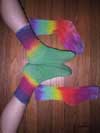
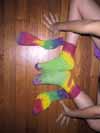

Procion MX dyes are among the very best for dyeing cotton and rayon.




 Socks do not need to be tied to have the look that everyone immediately identifies as tie-dye. Socks can be dyed best by simply laying them flat and dripping dye onto them, then flipping them over and repeating the same design on the other side. If you want white areas left between the colors, ties or rubber bands will resist the dye, leaving white areas; otherwise, leave them untied.
Socks do not need to be tied to have the look that everyone immediately identifies as tie-dye. Socks can be dyed best by simply laying them flat and dripping dye onto them, then flipping them over and repeating the same design on the other side. If you want white areas left between the colors, ties or rubber bands will resist the dye, leaving white areas; otherwise, leave them untied.

 Don't buy cheap socks, if that means that they are
uncomfortable or undersized. Your work is worth the cost of
even the most expensive of cotton socks. Buy soft,
comfortable socks. Mercerized cotton dyes better than even
ordinary cotton, as the processing makes the cotton able to
accept more dye, but the only mercerized cotton socks I've
found were too
narrow and too tight. My favorite kids' socks are the 100%
pima cotton socks from Lands' End [note: these are no longer available, as they have been replaced by 18% polyester socks, which may or may not be as satisfactory for dyeing, depending on where the polyester is located in the sock]; my favorite women's knee
socks come from the Vermont Country Store, but I've found
some good ones in our local Target department store. Maggie's Organics sells white socks which are extremely satisfactory for dyeing, but which cost more than other sources.
Don't buy cheap socks, if that means that they are
uncomfortable or undersized. Your work is worth the cost of
even the most expensive of cotton socks. Buy soft,
comfortable socks. Mercerized cotton dyes better than even
ordinary cotton, as the processing makes the cotton able to
accept more dye, but the only mercerized cotton socks I've
found were too
narrow and too tight. My favorite kids' socks are the 100%
pima cotton socks from Lands' End [note: these are no longer available, as they have been replaced by 18% polyester socks, which may or may not be as satisfactory for dyeing, depending on where the polyester is located in the sock]; my favorite women's knee
socks come from the Vermont Country Store, but I've found
some good ones in our local Target department store. Maggie's Organics sells white socks which are extremely satisfactory for dyeing, but which cost more than other sources.


 100% cotton will dye well, but a small percentage of Lycra
will make them stretch and stay up better. Lycra (a brand name for spandex fiber) will
not dye. Sometimes Lycra has cotton spun around it, so
you can't see undyed fiber anywhere in the finished
sock; other socks, especially tube socks, have Lycra
even on the outside, where it remains white, giving a
sort of heathered effect. Polyester will not dye at
all (see disperse
dye for polyester); nylon will not dye unless
heated with the dye in the presence of an acid such as
vinegar.
Cotton tights dye wonderfully; try to get those that are at
least 80% cotton. Both heavy wool hiking socks and
diaphanous nylon stockings can be dyed with
heat, acid, and acid dye; see Acid Dyes for Protein
Fibers and Nylon.
100% cotton will dye well, but a small percentage of Lycra
will make them stretch and stay up better. Lycra (a brand name for spandex fiber) will
not dye. Sometimes Lycra has cotton spun around it, so
you can't see undyed fiber anywhere in the finished
sock; other socks, especially tube socks, have Lycra
even on the outside, where it remains white, giving a
sort of heathered effect. Polyester will not dye at
all (see disperse
dye for polyester); nylon will not dye unless
heated with the dye in the presence of an acid such as
vinegar.
Cotton tights dye wonderfully; try to get those that are at
least 80% cotton. Both heavy wool hiking socks and
diaphanous nylon stockings can be dyed with
heat, acid, and acid dye; see Acid Dyes for Protein
Fibers and Nylon.
 Cotton of any sort is best dyed with cool water fiber reactive dyes
using the usual easy squirt bottle
dyeing recipe. Following this recipe, you pre-soak the socks in
a bucket of water with soda ash, wring them out with gloved
hands, lay them flat, and use squeeze bottles to squirt on
cool water fiber reactive dye, such as Procion MX dye, which
has been dissolved in water with some urea added. Leave
the socks damp with the dye overnight, at 70 degrees F (21 C) or higher
(warmer is better),
then wash the excess dye out the next day.
Cotton of any sort is best dyed with cool water fiber reactive dyes
using the usual easy squirt bottle
dyeing recipe. Following this recipe, you pre-soak the socks in
a bucket of water with soda ash, wring them out with gloved
hands, lay them flat, and use squeeze bottles to squirt on
cool water fiber reactive dye, such as Procion MX dye, which
has been dissolved in water with some urea added. Leave
the socks damp with the dye overnight, at 70 degrees F (21 C) or higher
(warmer is better),
then wash the excess dye out the next day.
 My favorite dyeing surface is
composed of a stiff 1/4" (6 mm) galvanized wire grid known as
hardware cloth, mounted in a frame to keep the edges
steady, and placed atop short sawhorses or a set of
table legs, out in the back yard. Window screen is too
fine and collects a puddle of dye. Some dyers use layers of
an absorbant material such as paper towels, or lay
things out on the lawn (the dye doesn't hurt the
grass, though the soda ash might, and the urea is a
fine fertilizer, in moderation), or just place into
rectangular glass dishes, or onto tables covered with
plastic.
My favorite dyeing surface is
composed of a stiff 1/4" (6 mm) galvanized wire grid known as
hardware cloth, mounted in a frame to keep the edges
steady, and placed atop short sawhorses or a set of
table legs, out in the back yard. Window screen is too
fine and collects a puddle of dye. Some dyers use layers of
an absorbant material such as paper towels, or lay
things out on the lawn (the dye doesn't hurt the
grass, though the soda ash might, and the urea is a
fine fertilizer, in moderation), or just place into
rectangular glass dishes, or onto tables covered with
plastic.

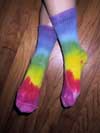 My younger son refused to wear any socks but
rainbow dyed ones, from ages two through six, and
still prefers them to all other socks. Other
parents ask me where I bought them. Rainbow
socks always look great. You can make the stripes
horizontal or vertical. A strict rainbow sock starts
at red, then proceeds through orange, then yellow (a
wide strip of yellow, as the adjacent colors tend to
overrun it), then green, turquoise, blue, and finally
violet. Modified rainbow socks combine only adjacent
colors from the rainbow next to each other, but do not
proceed in order; for example, they might start with
purple, go through fuchsia, yellow, and then green, or
blue, green, yellow, then back through green and blue
again. The main rule is simple: never put opposite
colors next to each other. Do not put scarlet next to
purple, as yellow from the red will mix with purple to
make mud brown. Mud does not belong in the rainbow. Never
put red next to green, orange next to blue, or yellow
next to purple. Always separate red from purple with a
band of fuchsia.
My younger son refused to wear any socks but
rainbow dyed ones, from ages two through six, and
still prefers them to all other socks. Other
parents ask me where I bought them. Rainbow
socks always look great. You can make the stripes
horizontal or vertical. A strict rainbow sock starts
at red, then proceeds through orange, then yellow (a
wide strip of yellow, as the adjacent colors tend to
overrun it), then green, turquoise, blue, and finally
violet. Modified rainbow socks combine only adjacent
colors from the rainbow next to each other, but do not
proceed in order; for example, they might start with
purple, go through fuchsia, yellow, and then green, or
blue, green, yellow, then back through green and blue
again. The main rule is simple: never put opposite
colors next to each other. Do not put scarlet next to
purple, as yellow from the red will mix with purple to
make mud brown. Mud does not belong in the rainbow. Never
put red next to green, orange next to blue, or yellow
next to purple. Always separate red from purple with a
band of fuchsia.




 Socks mottled with various colors can be subtle, or clown-like. You can even make more precise designs, such as argyle.
Socks mottled with various colors can be subtle, or clown-like. You can even make more precise designs, such as argyle.
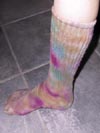
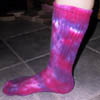
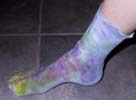
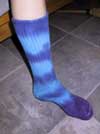
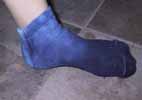
 Do you work in an office where tie-dye would be considered
wildly out of place? The stealth sock shows only staid
navy, black, or khaki above the shoe, but erupts into
bright colors such as red and orange when you take your
shoes off!
Sadly, all of my husband's stealth socks proved so popular
that they have been completely worn out and thrown away. I
need to make some more.
The pair pictured to the left are too bright in the upper
portion to truly qualify as stealth socks, though they do
give a misleadingly normal impression with casual wear.
Do you work in an office where tie-dye would be considered
wildly out of place? The stealth sock shows only staid
navy, black, or khaki above the shoe, but erupts into
bright colors such as red and orange when you take your
shoes off!
Sadly, all of my husband's stealth socks proved so popular
that they have been completely worn out and thrown away. I
need to make some more.
The pair pictured to the left are too bright in the upper
portion to truly qualify as stealth socks, though they do
give a misleadingly normal impression with casual wear.
 See more
answers to questions about dyes and dyeing
See more
answers to questions about dyes and dyeing